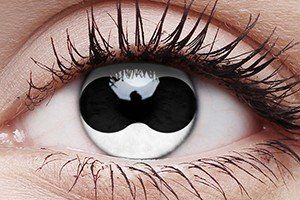

Prosthetic soft contact lenses only correct the spherical component of the refractive error. Type-C design with hydrogels material considered because of well centered capability, market dominance, a wide range of parameters availability and familiar tinting processes. To manage this condition, the prosthetic soft contact lens was considered as the best option. Finally, it was possible to conclude that the monocular diplopia was not corneal in origin.Īnother attempt was undertaken to mask pupil irregularity and to make light pass only through the central optical media. However, monocular diplopia was still present and annoying the patient. With this RGP contact lens in position VA was improved to 20/20. Adequate edge clearance, smooth and acceptable post blink movement, a stable lens in all directions of gaze, minimal edge lift inferiorly, and optic zone fully covered the pupil. Using the final lens parameter BC 7.00 mm, BVP −8.75 Ds, and TD 9.20 mm, both the dynamic and static lens fittings suggested an acceptable fit. Further 2 trials were performed by modifying a lens base curve and diameter. Both the static and dynamic fitting assessments suggested a flat fit.
#Double pupil contact lense trial
The first trial lens parameters were BC 7.50 mm, BVP −5.00 DS, and TD 10.40 mm. The initial contact lens parameters such as base curve and diameter were selected based on the fellow eye’s measurement. The rigidity of FP 100 material satisfactorily masking corneal surface irregularities. Therefore, classic RGP contact lens (classic laboratory, Bangalore, India, FP 100 material, spherical design) option was discussed with the patient. Corneal origin diplopia is best corrected with RGP contact lenses. Finally, a combination of prosthetic soft contact lens and spectacle correction was able to remove diplopia and provide binocular single vision.ĭuring clinical examination, the presence of corneal scarring, an irregular corneal surface, and irregular astigmatism might cause monocular diplopia. A range of different optical management options were implemented to eliminate monocular diplopia and to correct refractive error. Slit-lamp examination on the left eye revealed scarring in the superior nasal quadrant of the cornea, irregular mid-dilated pupil with exposed aphakic and pseudophakic portions.


Upon contact lens clinic presentation, visual acuities were 20/20 in the right and 20/320 in the left eye (improved to 20/25 with pinhole). Following the final intraocular lens implantation, he experienced a monocular double vision in his left eye. He had a penetrating ocular injury in the left eye and subsequently, undergone for multiple ocular surgeries. A 26-years-old student presented to the Institute with a complaint of monocular double vision in the left eye. Post-surgical or traumatic corectopia is among the rare causes of monocular diplopia.


 0 kommentar(er)
0 kommentar(er)
